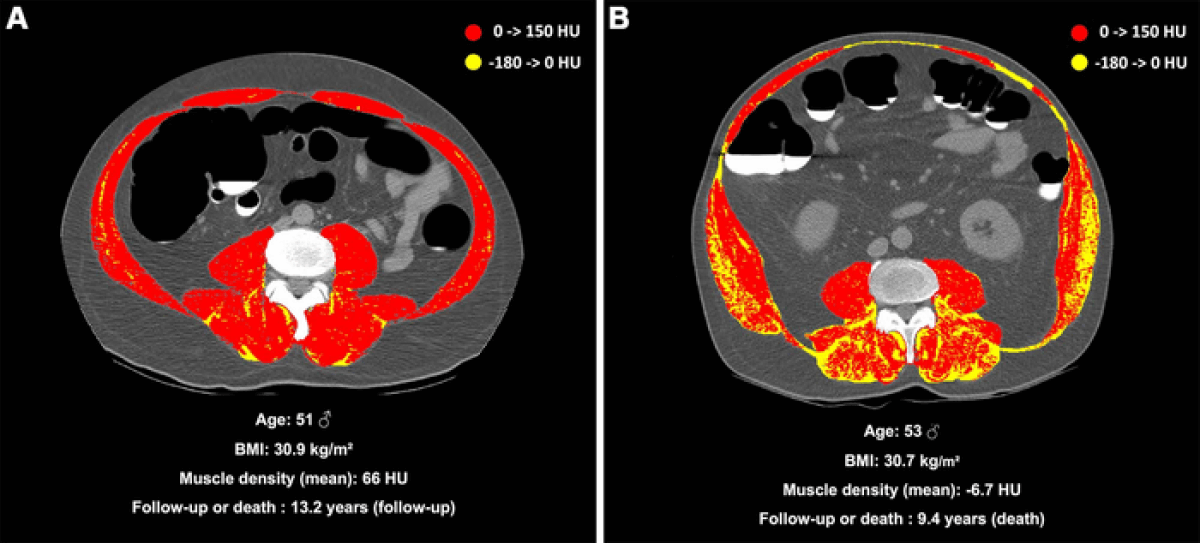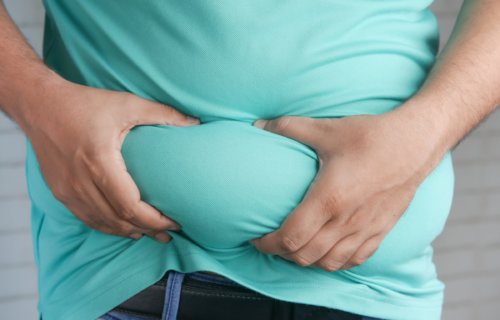OAK BROOK, Ill. — Having a pot belly or muffin top may not be the worst thing for your health. Instead, new research finds people with a high concentration of fat in their muscles, a condition known as myosteatosis, are twice as likely to die prematurely compared to their counterparts with excess abdominal fat.
Myosteatosis, which often has no symptoms, can lead to serious health conditions such as heart attacks or strokes. This finding may pave the way for a screening program and personalized treatments for those most at risk.
A study involving nearly 9,000 adults revealed a 10-year mortality risk of 15.5 percent for those with myosteatosis, compared to 7.6 percent for obese individuals. This risk even surpassed factors like fat around abdominal organs, fatty liver disease, and was comparable to risks associated with smoking or having Type 2 diabetes. Despite mounting evidence of its danger, myosteatosis remains largely overlooked in the medical community.
“Interestingly, the correlation was independent of age or obesity indicators such as BMI,” says study co-author Dr. Maxime Nachit in a media release. “This suggests that muscle fat accumulation is not simply a result of aging or having excessive fat in other body areas.”
Is BMI getting it wrong?
Physicians often use the Body Mass Index (BMI) to estimate a patient’s body fat. However, since BMI is calculated based on a patient’s height and weight, it doesn’t accurately reflect body composition. Individuals with similar BMIs can have significantly different health risks and co-morbidities. Future research could clarify whether myosteatosis merely indicates poorer health status or if it directly contributes to an increased risk of death.
“We’re seeing the advent of ‘personalized medicine’ that aims to customize medical management based on a range of information, including genetics, medical history, physical characteristics, and complex molecular evaluations. Our study shows that myosteatosis, identifiable from routine medical images, is a reliable indicator of an individual’s short-term mortality risk,” adds Dr. Nachit, a post-doctoral researcher at the Institut de Recherche Expérimentale et Clinique at UCLouvain in Brussels.
Scroll down to see the 9 best ways to reduce visceral fat

Typically, doctors find myosteatosis among patients already sick and undergoing medical imaging for another illness. However, little is known about its health risks in asymptomatic patients.
To address this, the researchers utilized artificial intelligence, specifically machine learning, to extract body composition metrics from abdominal CT scans of asymptomatic adults who underwent routine bowel cancer screenings between 2004 and 2016. The study recorded major adverse events, such as heart attacks, strokes, aneurysms, and deaths. Myosteatosis was identified in 55 percent of the 507 participants who died during the average follow-up period of almost nine years.
“To date, medical imaging with CT or MRI remains the gold standard to evaluate myosteatosis,” Dr. Nachit concludes.
In light of these findings, Dr. Nachit and his team aim to further understand the relationship between myosteatosis and mortality risk, while also studying visceral fat, liver steatosis, muscle wasting, and obesity.
The study is published in the journal Radiology.
How can you get rid of visceral fat?
Visceral fat is a type of body fat that’s stored within the abdominal cavity. It’s located near several vital organs, including the liver, stomach, and intestines. Reducing visceral fat is crucial for overall health as it has been associated with a higher risk of conditions such as heart disease, Type 2 diabetes, and certain cancers. Here are some effective ways to reduce visceral fat:
- Healthy Eating: A balanced diet rich in lean proteins, whole grains, fruits, and vegetables can help reduce visceral fat. Avoiding processed foods, sugary drinks, and high-fat foods can also be beneficial.
- Physical Activity: Regular physical activity is essential. Both cardio exercises, like running, swimming, or cycling, and strength training can help burn calories and decrease body fat.
- Limit Alcohol Consumption: Excessive alcohol intake can lead to a variety of health problems, including an increase in visceral fat.
- Reduce Stress: High stress levels can affect your waistline. Engage in stress-reducing activities such as yoga, meditation, or deep breathing exercises.
- Adequate Sleep: Getting enough sleep is crucial for overall health and can help regulate your body’s fat storage.
- Avoid Sugary Foods and Beverages: High sugar intake is linked to increased visceral fat. This includes not only sweets but also sugary beverages, including fruit juices and soda.
- Limit Trans Fats: These artificially produced fats are found in many packaged foods and baked goods, and they’re linked to an increase in visceral fat.
- Increase Protein Intake: A high protein diet can help you feel fuller, increase your metabolic rate, and help retain muscle mass during weight loss, all of which can help reduce visceral fat.
- Drink Plenty of Water: Staying hydrated is essential for health and can help you control your appetite, which may help with weight loss and fat reduction.
Remember to consult with a healthcare provider before making significant changes to your diet or exercise regimen. They can provide guidance tailored to your specific health needs and goals.
South West News Service writer Mark Waghorn contributed to this report.


You Suggest: “A balanced diet rich in lean proteins, whole grains, fruits, and vegetables can help reduce visceral fat. Avoiding processed foods, sugary drinks, and high-fat foods can also be beneficial.”
Do you realize this is the same diet along with restricted exercise that is prescribed for cattle to increase weight and increase the marbling (fat) in the muscle meat before market? How can you expect this to reduce any fat in humans?